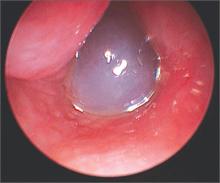Nasal obstruction
A 35-year-old man complained to his family physician (FP) of unilateral nasal obstruction that had become increasingly bothersome over the previous few months. The patient had a history of allergic rhinitis and took loratadine daily. An examination of the nose revealed a pearly pale mass.
What’s your diagnosis?
The FP diagnosed a nasal polyp, secondary to allergic rhinitis, in this patient. Nasal polyps are benign lesions arising from the mucosa of the nasal passages, including the paranasal sinuses. They are most commonly semitransparent.
Nasal polyps are associated with the following conditions:
- nonallergic and allergic rhinitis and rhinosinusitis
- asthma
- cystic fibrosis
- aspirin intolerance
- alcohol intolerance.
Medical treatment consists of intranasal corticosteroids. An initial short course (2-4 weeks) of oral steroids may be considered in severe cases. Steroid treatment reduces polyp size, but is not likely to eliminate them. Oral doxycycline 100 mg daily for 20 days was shown to decrease polyp size, providing benefit for 12 weeks in one randomized controlled trial. Topical nasal decongestants may provide some symptom relief, but will not reduce polyp size. Montelukast reduces symptoms when used as an adjunct to oral and inhaled steroid therapy in patients with bilateral nasal polyposis. Surgical excision is often required to relieve symptoms.
The FP prescribed nasal fluticasone daily and the patient had some relief, but his obstructive symptoms persisted. After 2 months of persistent symptoms, the patient was referred to an otolaryngologist to discuss the benefits and risks of polypectomy.
Photo courtesy of William Clark, MD. Text for Photo Rounds Friday courtesy of Richard P. Usatine, MD. This case was adapted from: French L. Nasal polyps. In: Usatine R, Smith M, Mayeaux EJ, et al. Color Atlas of Family Medicine. 2nd ed. New York, NY: McGraw-Hill; 2013:193-196.
To learn more about the Color Atlas of Family Medicine, see: https://www.amazon.com/Color-Family-Medicine-Richard-Usatine/dp/0071769641/ref=dp_ob_title_bk
You can now get the second edition of the Color Atlas of Family Medicine as an app for mobile devices by clicking this link: https://usatinemedia.com/





